We’ll explain everything from the definition of Mobile Ad Fraud to best practices for protecting your business, and we’ll even discuss future trends and offer insights on how to stay ahead of the game.
Have you noticed how mobile advertising has become increasingly important as the use of mobile devices continues to grow?
Well, it’s not just a passing trend. Global mobile ad spend stood at approximately 234 billion U.S. dollars in 2019. By 2024, this figure is projected to reach 495 billion U.S. dollars.
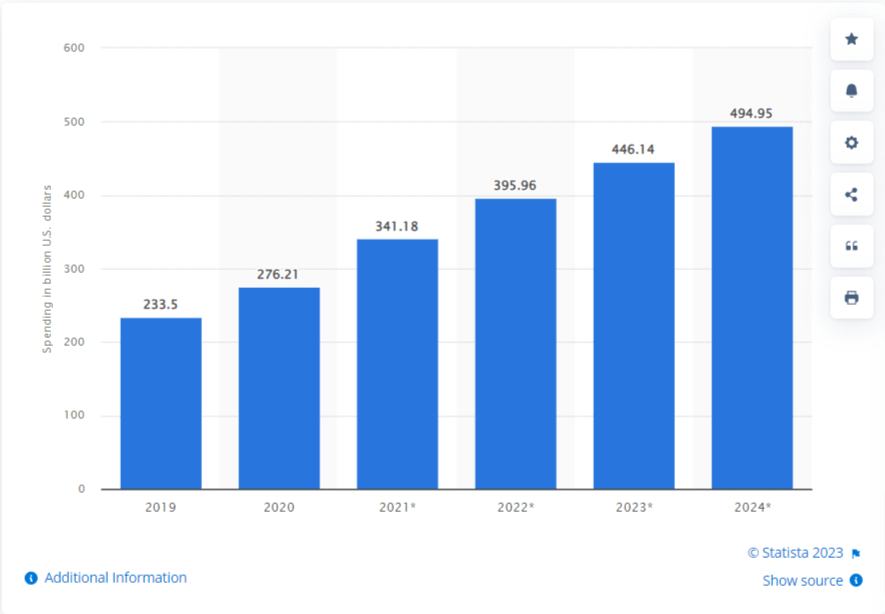
But with this growth comes a heightened risk of mobile ad fraud, which can include fake clicks, impressions, and installs that can be costly and damaging for businesses and advertisers alike.
That’s why it’s crucial to understand what mobile ad fraud is, its different types, and the measures you can take to prevent it.
As a marketer or advertiser, it’s important to stay informed about the latest developments in ad fraud, and we’re here to help.
Also Read: How to Detect Ad Fraud & Prevention Tips for Digital Publishers
Definition of Mobile Ad Fraud
Mobile ad fraud is a type of fraud that occurs in the mobile advertising ecosystem. It refers to fraudulent activities that artificially inflate mobile advertising performance metrics, resulting in wasted ad spend and potential harm to brand reputation.
Here are some common ad fraud tactics to be aware of:
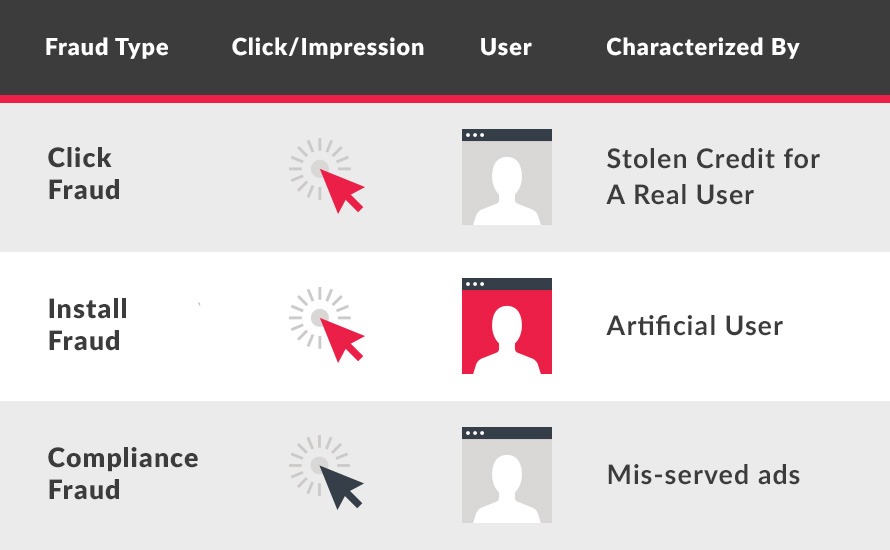
Click Fraud: Click fraud is a tactic in which fraudsters generate fake clicks on mobile ads, creating the illusion of user engagement. It can be accomplished using bots or by employing click farms.
Impression Fraud: Impression fraud occurs when fraudsters create fake impressions, which are the number of times an ad appears on a user’s screen. It can be achieved by using bots to generate fake impressions or by placing ads in invisible or hidden parts of a mobile app or website.
Install Fraud: Installing fraud is a tactic in which fraudsters generate fake app installs to make it appear that their ads are more effective than they actually are. It can be achieved using bots or incentivized installs, which are installs generated by offering users rewards or incentives for downloading an app.
Click Here to see our Webinar: Against Ad Fraud and Towards Transparency
Why is Understanding Mobile Ad Fraud Important?
Understanding mobile ad fraud is crucial for businesses and advertisers. Here are some reasons why:
Wasted Ad Spend
Mobile ad fraud can result in wasted ad spend, as fraudulent activities can create the illusion of user engagement when there is none. By understanding ad fraud and taking preventive measures, businesses can ensure that their ad spend is being used effectively.
Damage to Brand Reputation
Mobile ad fraud can harm brand reputation by causing businesses to appear less credible. When fraudulent activities are discovered, it can damage the trust that consumers have in the brand.
Legal Consequences
Mobile ad fraud can sometimes lead to legal consequences. Fraudulent activities can violate consumer protection laws, which can result in fines or legal action.
Businesses and advertisers can protect their ad spend, reputation, and legal standing by understanding ad fraud and taking preventive measures.
Read More: 5 Common Types of Ad Fraud (and How They Affect Publishers)
Types of Mobile Ad Fraud [In Detail]
Businesses should be aware of several types of ad fraud. Understanding these types of fraud can help in the prevention of fraud, and ensure that ad spend is being used effectively. Have a look are some of the most common types of mobile ad fraud:
Click Fraud
Click fraud occurs when fraudsters generate fake clicks on mobile ads, creating the illusion of user engagement.
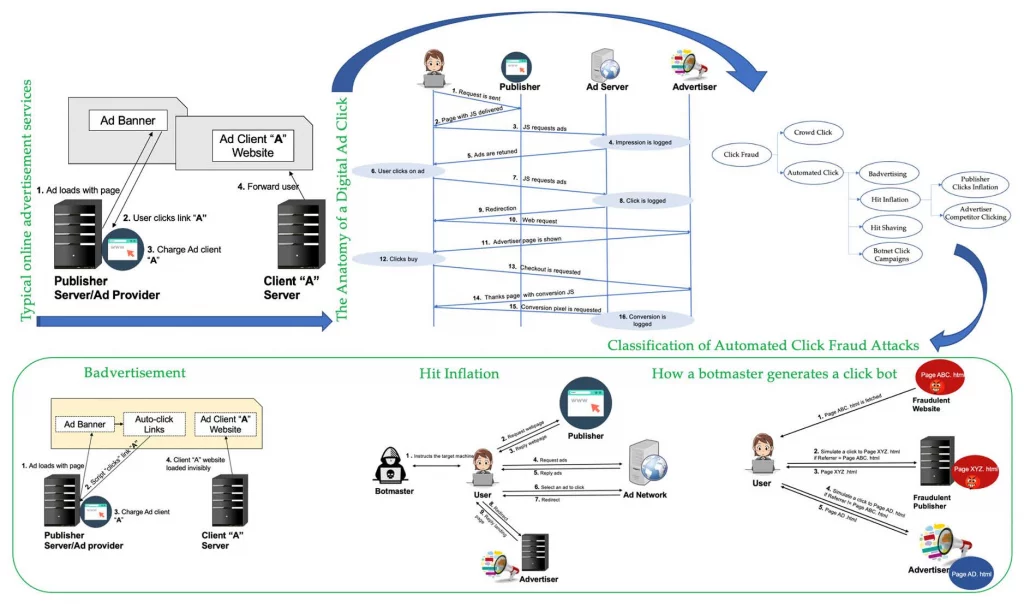
It can be accomplished using bots or by employing click farms, groups of individuals paid to click on ads repeatedly.
Click fraud can also be accomplished by using malware that forces a mobile device to click on an ad without the user’s knowledge.
Impression Fraud
Impression fraud occurs when fraudsters create fake impressions, which are the number of times an ad appears on a user’s screen.
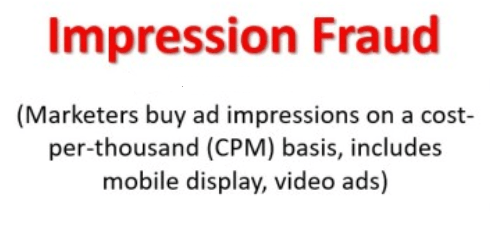
Using bots to generate fake impressions or placing ads in invisible or hidden parts of a mobile app or website can be achieved. In some cases, impression fraud can be accomplished by manipulating a user’s device to generate fake impressions.
Install Fraud
Installing fraud is a tactic in which fraudsters generate fake app installs to make it appear that their ads are more effective than they actually are.
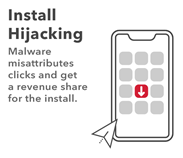
It can be achieved using bots or incentivized installs, which are installs generated by offering users rewards or incentives for downloading an app.
Install fraud can also be accomplished by using install farms, groups of individuals paid to download and install apps repeatedly.
Attribution Fraud
Attribution fraud is a type of fraud that occurs when fraudsters manipulate the attribution process to take credit for installs or clicks that they did not generate.
It can be accomplished by using click injection, a technique where a fraudulent app is installed on a device that has previously clicked on an ad.
The fraudulent app then sends a fake click to take credit for the original click.
SDK Spoofing
SDK spoofing is a tactic in which fraudsters manipulate the software development kit (SDK) used to track app installs and other user engagement metrics.
It can be accomplished by intercepting the SDK requests and replacing them with fraudulent data, making it appear fraudulent activities generate user engagement.
Examples of Mobile Ad Fraud
Here are some examples of mobile ad fraud in action:
- A fraudulent app developer uses a click farm to generate fake clicks on their mobile ads, making it appear that their ads are more effective than they are.
- A fraudster uses bots to generate fake impressions on mobile ads, creating the illusion of user engagement.
- A fraudster uses incentivized installs to generate fake app installs, making it appear as though their app is more popular than it actually is.
By understanding the different types of mobile ad fraud, businesses and advertisers can take preventive measures to protect their ad spend and ensure that their campaigns are effective.
Also Check: Invalid Traffic Identification and Protection for Publishers
Preventive Measures for Mobile Ad Fraud
Mobile ad fraud is an ever-increasing threat to digital advertising, and preventing it requires a multi-layered approach. Let us reflect on some of the most effective preventive measures for mobile ad fraud.
Ad Fraud Detection Tools
One of the most important preventive measures for mobile ad fraud is the use of ad fraud detection tools. These tools use advanced algorithms to analyze mobile ad traffic and identify potential fraud.
Some of the most popular ad fraud detection tools in the market today include DoubleVerify, MOAT, and Pixalate. Ad fraud detection tools are beneficial because they can help identify fraud before it becomes a significant issue.
Verification Processes
Another crucial preventive measure for mobile ad fraud is implementing verification processes in mobile advertising. Verification processes include steps such as verifying ad impressions and installs and confirming that ads are being displayed to actual users rather than bots.
Industry leaders like Google and Facebook have implemented verification processes to combat mobile ad fraud. Verification processes are beneficial because they ensure advertisers only pay for genuine traffic and avoid wasting money on fraudulent traffic.
Transparency in Ad Buying
Transparency in ad buying is another effective measure in preventing mobile ad fraud. When buying mobile ads, it is essential to know exactly where the ads will be displayed and who will see them.
Advertisers should demand transparency from their partners and ensure that all parties involved in ad-buying follow ethical and transparent practices. Advertisers should avoid buying ads from unknown sources and stick to reputable partners. Transparency in ad buying is beneficial because it helps advertisers avoid fraud by ensuring their ads are displayed in legitimate contexts.
In addition to the measures listed above, there are several best practices that advertisers can implement to prevent mobile ad fraud.
These best practices include monitoring for:
- Suspicious activity
- Verifying the quality of traffic
- Using anti-fraud technology
By implementing these best practices, advertisers can significantly reduce the risk of mobile ad fraud.
Future Trends in Mobile Ad Fraud
Mobile ad fraud is a constantly evolving threat, and being aware of the latest trends is essential for businesses looking to protect their ad investments.

In 2023 and beyond, we expect several new trends in ad fraud, including using artificial intelligence (AI) and machine learning to detect and prevent fraudulent activity.
One potential trend in mobile ad fraud is using AI and machine learning to create more sophisticated and convincing fraud schemes.
As these technologies become more advanced, fraudsters can generate more convincing fake clicks, installs, and impressions, making it more difficult for businesses to detect and prevent fraud.
To stay ahead of these trends, businesses must invest in advanced ad fraud detection tools that leverage AI and machine learning to identify fraudulent activity. These tools can help businesses identify and prevent fraud in real time, allowing them to take action before the damage is done.
- Another significant trend in mobile ad fraud is the growing emphasis on transparency and accountability in the ad buying process.
As consumers become more aware of the risks of mobile ad fraud, they demand greater transparency from advertisers and publishers.
To meet this demand, businesses will need to adopt more transparent ad-buying practices and provide greater visibility in their ad campaigns.
It may include providing detailed reports on ad impressions, clicks, and installs and partnering with trusted third-party verification services to validate ad performance and ensure that campaigns are running as intended.
Mobile ad fraud seriously threatens businesses that rely on mobile advertising to reach their target audiences.
By understanding the latest trends in ad fraud and investing in advanced ad fraud detection tools and transparent ad-buying practices, businesses can protect themselves from this growing threat and continue to drive results through mobile advertising in 2023 and beyond.
Final Words on Mobile Ad Fraud
Mobile ad fraud is a severe problem that will rise in 2023. Businesses need to understand what mobile ad fraud is, the different types, and how to prevent it.
By implementing best practices and utilizing the latest technologies, businesses can protect themselves from ad fraud and avoid losing significant amounts of money to fraudsters.
Ad fraud doesn’t just hurt publishers, it ends up damaging the whole advertising ecosystem. To the relief of the publishers, AdPushup is a revenue optimization platform that helps publishers increase their ad revenue using ad layout optimization, header bidding, innovative ad formats, ad mediation, adblock recovery, and accelerated mobile pages. Sign up here to learn more.
FAQs
It is a form of advertising fraud in which fraudulent activities are carried out to generate false clicks, impressions, or installs on mobile ads. It involves exploiting vulnerabilities in the mobile advertising ecosystem to cheat advertisers and publishers out of their advertising budgets.
Ad fraud (mobile) can occur through various tactics, such as click spamming, install farms, SDK spoofing, and click injection. These tactics involve manipulating the mobile advertising system to generate fake clicks, impressions, and installs, leading to inflated advertising costs for businesses.
The consequences of ad fraud can be significant for businesses. They can lose their advertising budgets to fraudsters, impacting their ability to generate revenue and grow their business. Additionally, businesses may experience damage to their reputation due to fraudulent activities associated with their ads.
Businesses can protect themselves from ad fraud by implementing best practices, such as using ad fraud detection tools, utilizing verification processes, and practicing transparency in ad buying. They can also work with reputable ad networks and partners and stay informed about the latest trends in ad fraud.
Yes, AI and machine learning can be used to prevent ad fraud by analyzing large datasets to identify patterns that may indicate fraudulent activity. These technologies can help businesses detect and prevent ad fraud in real-time, thereby saving them time and money.
Yes, ad fraud (mobile) is expected to be a growing problem in 2023 as mobile advertising continues to grow. Fraudsters are becoming more sophisticated, making it more challenging for businesses to detect and prevent fraud.

Shubham is a digital marketer with rich experience working in the advertisement technology industry. He has vast experience in the programmatic industry, driving business strategy and scaling functions including but not limited to growth and marketing, Operations, process optimization, and Sales.

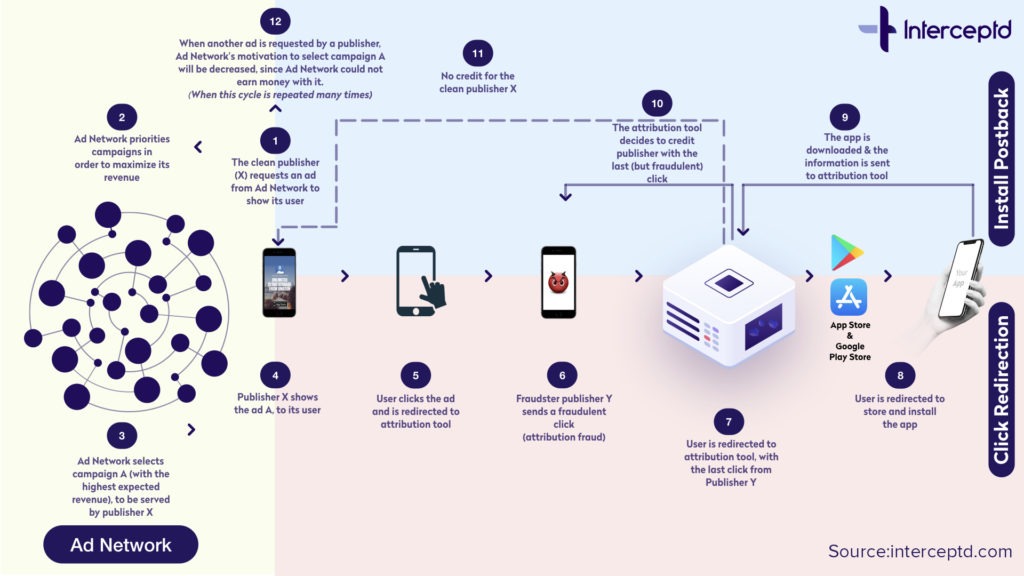



![CTV vs OTT Advertising: Which one is Right Pick for Publishers? + [6 Bonus Strategies] Ott vs Ctv](png/featured-image-270x180.png)


